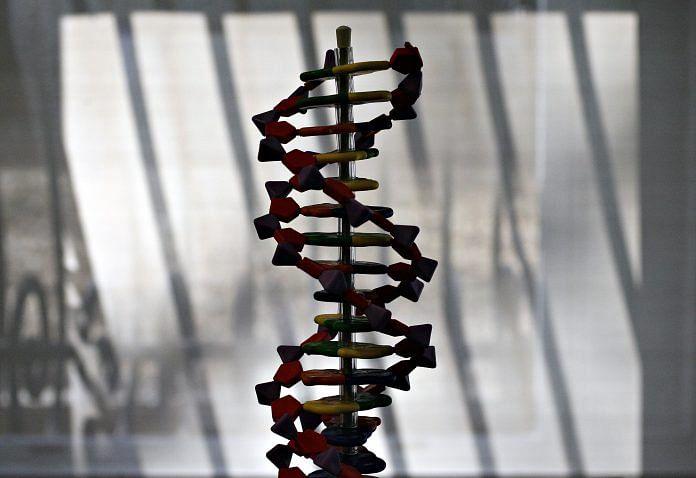New Delhi: A piece of genetic code that humans have inherited from the Neanderthals — which was found linked to increased risk of severe Covid disease — protects humans from HIV, according to a new study that provides insight into a piece of human DNA that has intrigued scientists for two years.
Neanderthals are an extinct species of ancient humans who lived in Eurasia until about 40,000 years ago.
Hugo Zeberg and Svante Pääbo at Max Planck Institute for Evolutionary Anthropology in Germany have been studying the piece of genetic code since 2020. They found that a part of genetic code in chromosome 3, that made us more susceptible to severe Covid, had been inherited from the Neanderthals more than 50,000 years ago.
Chromosomes are thread-like structures located inside the nucleus of cells. Each chromosome is made of protein and a single molecule of deoxyribonucleic acid (DNA). The DNA contains the specific instructions or genetic code that makes each individual unique.
Humans have 23 pairs of chromosomes. People normally have two copies of each chromosome.
In a study published in The New England Journal of Medicine in October 2020, researchers had found a strong link between severe Covid-19 and two genomic regions: one region on chromosome 3 containing six genes, and one region on chromosome 9 that determines the ABO blood group.
Chromosome 3 spans almost 200 million base pairs or “letters”, and represents about 6.5 per cent of the total DNA in cells. Researchers found that a unique combination of about 50,000 base pairs in chromosome 3 puts people at risk of severe Covid-19.
The gene in question is carried by 30 per cent of the South Asian population, but is almost completely absent in African people.
The duo at Max Planck Institute for Evolutionary Anthropology found that the string of DNA that puts people at increased risk of severe Covid-19 is the same version found in a Neanderthal who lived in Croatia more than 50,000 years ago.
The team later also found that the DNA’s frequency has increased significantly since the last ice age. In fact, it has become unexpectedly common for a genetic variant inherited from Neanderthals.
What puzzled the scientists is that a gene that make humans susceptible to a disease should not survive thousands of years of evolution. The only reasonable explanation to that is that this piece of DNA coding had a favourable impact that the scientists did not know of.
“This major genetic risk factor for COVID-19 is so common that I started wondering whether it might actually be good for something, such as providing protection against another infectious disease,” Zeberg said in a statement.
The genetic risk factor is located in a region on chromosome 3 that consists of many genes. There are several genes in its vicinity that encode receptors in the immune system.
One of these receptors — CCR5 — is used by the HIV virus to infect white blood cells.
Also read: Pfizer’s combo drug Paxlovid could reduce risk of severe Covid by 89%, shows trial in US
A new question
In the latest study, published Tuesday in PNAS, Zeberg found that people who carried the risk factor for Covid-19 had fewer CCR5 receptors. This led him to test whether they also had a lower risk of becoming infected with HIV.
By analysing patient data from three major biobanks he found that carriers of the risk variant for Covid-19 had a 27 per cent lower risk of contracting HIV.
“This shows how a genetic variant can be both good and bad news: bad news if a person contracts COVID-19, good news because it offers protection against getting infected with HIV,” said Zeberg.
However, the findings raise new questions. HIV only arose during the 20th Century, so protection against this infectious disease cannot alone explain why the genetic risk variant for Covid-19 became so common among humans as early as 10,000 years ago.
“Now we know that this risk variant for COVID-19 provides protection against HIV. But it was probably protection against yet another disease that increased its frequency after the last ice age,” Zeberg said.
According to some scientists, modern humans migrated out of Africa and interbred with the Neanderthals in Eurasia some 200,000 years ago. Then 140,000 years later, Eurasians with Neanderthal ancestry migrated to Africa, interbreeding with the descendants of the humans who never left.
As a result, about 1-4 per cent of genomes of Eurasians, Native Americans, and North Africans derive from the Neanderthals. About 20 per cent of the Neanderthals’ genes continue to survive today in humans.
The highest frequency of this gene occurs in Bangladesh, where more than half the population (63 per cent) carries at least one copy of the Neanderthal risk variant, and 13 per cent have a similar variant of the gene segment.
About eight per cent of Europeans have this variant, while for mixed-race Americans, the variant is present in 4 per cent of the population.
(Edited by Nida Fatima Siddiqui)
Also read: Sickle cell disease could have a cure soon, gene therapy shows good results in clinical trial



